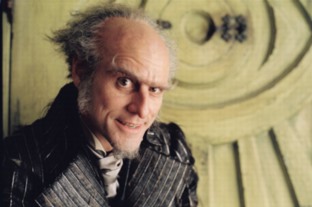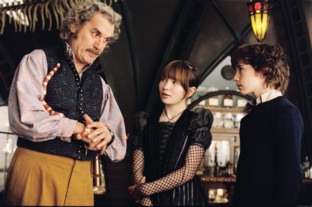|
It
is Hollywood wisdom that an actor is a man or woman who
convinces an audience they are someone else. A star (much
more important than an actor) is a man or woman who is able
to play an exaggerated version of him/herself in a series
of films intended to showcase their particular talents.
There are very few 'star' actors, personalities whose presence
can ensure a good opening weekend and who can also expect
to be well rewarded come Oscar night. Tom Hanks is probably
the best example of the 'star' actor, a man whose presence
can green light a project but also someone who can bring
significant thespian talent to bear and not just depend
on an increasingly overwrought physicality.
Then
there are the 'stars' who long to be taken seriously as
actors. Most stars go through this career phase. Bill Murray
had his Razor's Edge, Stallone his Copland and Tom Cruise his Magnolia. Some prove
themselves worthy of continued accolade and some crash and
burn thereby relying on and returning to the 'star' system
to keep them in the box office heavens. But Jim Carrey not
only appears to fall between the two stools, he gleefully
straddles them. Ace Ventura and The
Mask catapulted this manic Canadian into the box
office stratosphere. His wide faced, hyperactive, rubber
bodied persona was established (the star) and despite sequel
attractions (his agents must have been so frustrated that
their guaranteed meal ticket wanted to be an actor - hi
diddle-dee dee), Jim Carrey wanted to expand his repertoire. The Cable Guy, The Truman Show and Eternal Sunshine of the Spotless Mind proved
he could be versatile and believable. But was there a role
out there that could fold in Carrey’s acting ambitions
while retaining his strengths as a larger than life character.
Oh yes.

And
his name was Count Olaf. It certainly wasn't the Riddler
in the almost un-watchable Batman and Robin…
Here
is a über-decadent fop, a failed actor related in blood
to a family who suffer the titular series of unfortunate
events. Here is a potential child murderer but with flair
and panache (if one is able to claim such adjectives for
something as grievous as killing children). All the way
through this charming fantasy, ably directed by Brad Silberling,
I longed to see what Tim Burton may have made with the same
material, or even Gilliam whose movies Unfortunate
Events reminded me of, but Gilliam-lite. But most
of all, Burton would have brought Christopher Walken to
bear, a big gun for the role, tailor made. You'd believe
Walken would kill children - no stranger to such a deed
albeit without his head in Sleepy Hollow.
Olaf,
in the three Daniel Handler books upon which the film is
based, really needs to be more like the child catcher in Chitty Chitty Bang Bang, someone to give
children nightmares (which are apparently good for them
before someone objects to my cavalier attitude towards children’s
mental health). But as a safe Olaf, a non-threatening Olaf
(despite his schemes to bump off the three Baudelaire children
to get his mitts on their money), Carrey does an entertaining
job and in and of itself, that’s fine for such a light
pastry of a movie.
Unfortunate
Events takes place in an imaginary world and does
very well to introduce us to it non fussily and competently.
You never know which era the film is supposed to be set
and it's almost as if the three children have stepped in
from our 'real world' and experience the oddness of Olaf's
world just as we do. Jude Law as narrator and writer Lemony
Snicket is seen only in silhouette (what, was he cheaper
in just silhouette?). The movie starts in a delightfully
twee manner. The 70s, eastern European style, 3D animation
showcases The Happy Elf - a movie within a movie
that is soon subverted by Snicket's foreboding voice over.
We are not here to see happy elves cavorting about. Snicket
is saddened to inform us that we will be watching something
a lot darker with precious little happiness. We are introduced
to the three Baudelaire children (each cast to perfection
and that includes the triplets that were originally cast
to play the youngest child and the twins who eventually
got the role). They have lost their parents and home in
a raging fire of mysterious origin. The orphans are placed
in the custody of Count Olaf (Carrey in a number of disguises)
who attempts to kill all three on numerous occasions while
the children wise up and learn the truth about their parents.

The
older Baudelaire girl, Violet, has a talent for invention;
Klaus, her brother, a photographic memory stretched by all
the books he's read; Sunny, the baby (we are told) likes
to bite things. Aside from the Puss in Boots big eye shot
in Shrek 2, the shot of Sunny biting a
table and hanging suspended in mid air is a favourite of
mine from 2004. She also manages to have her thoughts subtitled
which is OK until the film makers get cute and turn her
into a comedian. Their first real trial is to escape from
a locked car parked on a railway line by Olaf as his first
attempt to entice a train to help him inherit the family
money. The ingenuity on display by the children is pointedly
unbelievable but hugely entertaining. The film then settles
into its template of Olaf wants to kill, the children thwart
him. Along the way we are treated to a cadre of characters,
each played by the most surprising faces.
Uncle
Monty (to outsiders all, a name that only applies to - and
must only apply to Withnail and I) is played
by Billy Connolly, a herpetologist (someone whose passion
is reptiles and amphibians). Could not the original author
have resisted the name 'Monty'? After all, he deals with
pythons… It's under his care that the children gain
confidence but they are all soon disabused of any happy
future with a man that knew the Baudelaire family well.
Olaf sees to that making sure that Monty dies in a convincingly
'poisoned' fashion. But wait, this is a different world
and only we know that the most horrific and deadly snake
in the world has an undeserved reputation. In another shot,
digitally animated to within an inch of its life (but still
entertaining nonetheless) it's the baby Sunny that provides
the snake's innocence.
Shipped
off to Aunt Josephine next, the children encounter Meryl
Streep in playful and neurotic mode. The scenes in her house
are among the most striking for the production design alone.
It's at this point that Carrey crops up again (wooden leg
in CG evidence) as a salty sea captain bent on marrying
Streep and therefore gaining control of the Baudelaire fortune.
The destruction of the house is as good and narratively
satisfying as anything out there for children right now.
George
Lucas’ effects house, ILM, does a remarkable job at
unifying the world in which Unfortunate Events is set - a sort of un-real cyclorama pastel CG world of
not quite real things - but they are consistent and that’s
what gives the film its edge. It has a through line and
a design that transports you. Yes, Burton or Gilliam may
have made an edgier effort but for a mainstream Hollywood
children’s film it steers clear of references and
therefore is a real film that stands on its own two feet.
|